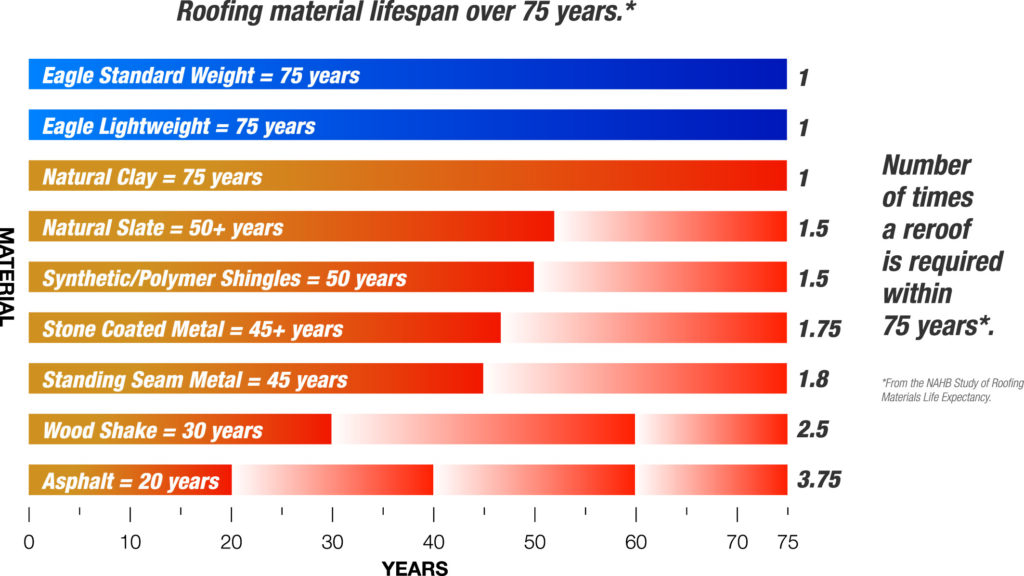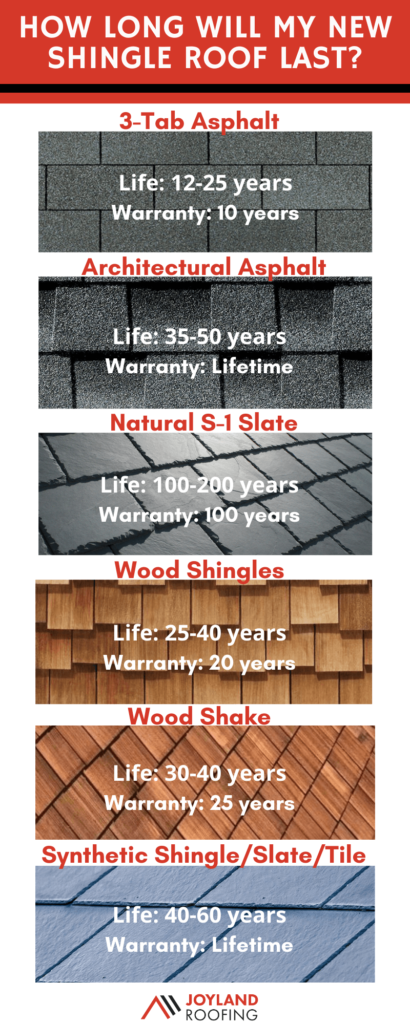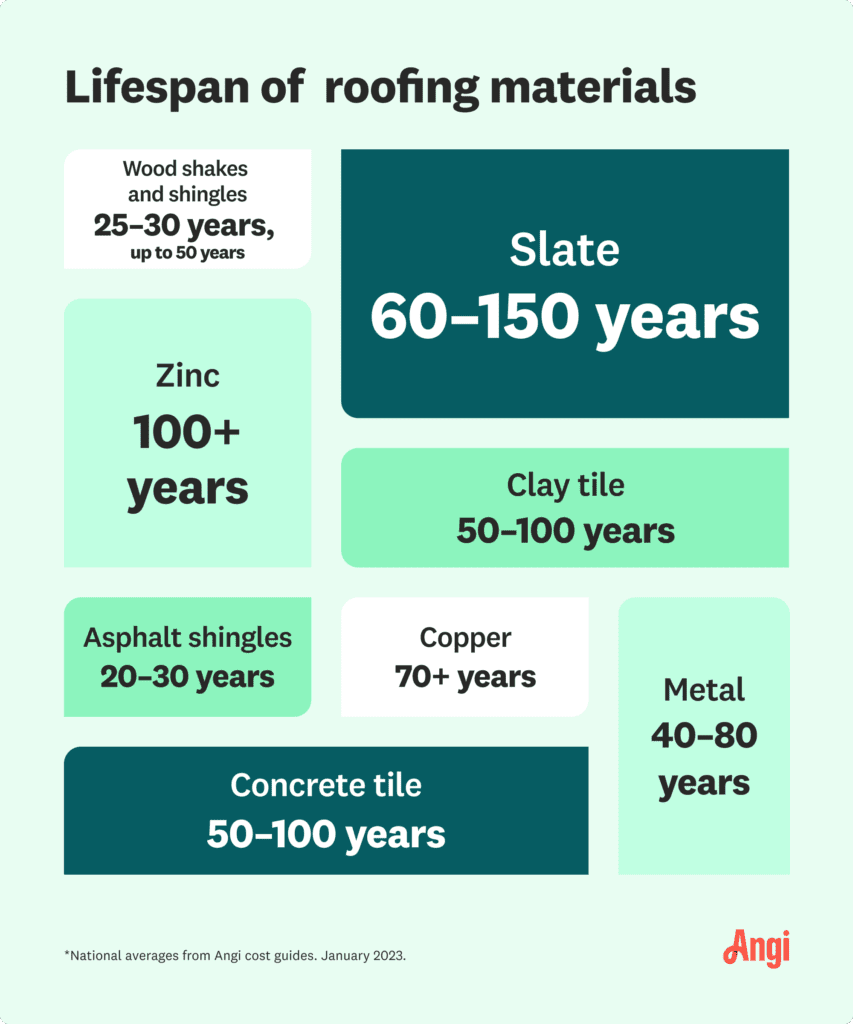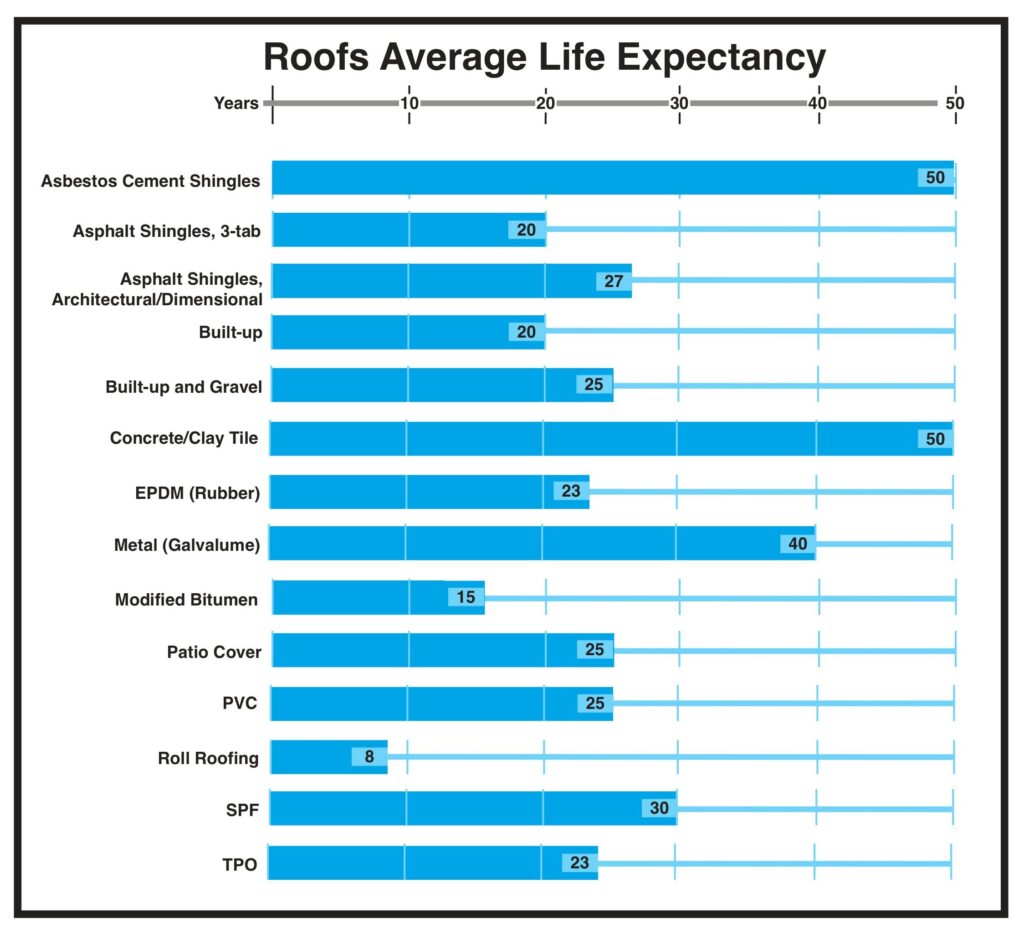Have you ever wondered how long your roof will last? The life expectancy of a roof is an important factor to consider when it comes to maintaining and protecting your home. Understanding the lifespan of your roof can help you plan for necessary repairs or replacements, ensuring the long-term durability and safety of your property. In this article, we will explore the various factors that can affect the lifespan of a roof and provide insights on how to maximize its longevity. Whether you are a homeowner or a prospective buyer, this information will be valuable in making informed decisions regarding your roof’s maintenance and care.

Factors Affecting Roof Life Expectancy
Having a durable and long-lasting roof is essential for the overall protection and structural integrity of your home. The life expectancy of a roof can vary depending on several factors. Let’s discuss the main factors that can impact the longevity of your roof.
Roofing Material
The choice of roofing material is one of the most critical factors influencing the life expectancy of your roof. Different materials have varying degrees of durability, resistance to weather elements, and overall lifespan. It’s important to choose a roofing material that suits your climate and budget to ensure the longevity of your roof.
Weather Conditions
The weather conditions in your area play a significant role in determining how long your roof will last. Exposure to extreme temperatures, strong winds, heavy rain, snow, or hail can weaken the roofing material and cause damage over time. If you live in an area with frequent severe weather events, it’s crucial to choose a roofing material that can withstand these conditions.
Installation Quality
The quality of the roof installation directly affects its lifespan. A properly installed roof ensures that all components are correctly positioned and securely fastened. Improper installation can lead to premature roof failure, leaks, and other issues. Hiring a professional and experienced roofing contractor is essential to ensure the installation is done correctly.
Maintenance
Regular maintenance is key to prolonging the life of your roof. It involves inspecting the roof for any damages, cleaning debris, and making necessary repairs. Neglecting maintenance can result in minor issues escalating into major problems, reducing the overall lifespan of your roof. Periodic inspections and prompt maintenance can significantly extend the life expectancy of your roof.
Roof Pitch and Design
The pitch or slope of your roof can impact its lifespan. A steeper roof pitch allows for better water runoff, which helps prevent water pooling and potential roof leaks. Additionally, the overall design of your roof, including the presence of valleys, dormers, and skylights, can also affect its vulnerability to damage from weather elements.
Types of Roofing Materials
When it comes to roofing materials, there are various options available. The choice of roofing material depends on several factors, including durability, aesthetics, cost, and availability. Let’s explore some of the most common types of roofing materials.
Asphalt Shingles
Asphalt shingles are one of the most popular and cost-effective roofing materials. They are available in a wide range of colors and styles, making them suitable for various architectural designs. Asphalt shingles have a lifespan of 15 to 30 years, depending on the quality of the shingles and the local climate.
Metal
Metal roofs are known for their durability and longevity. They are resistant to extreme weather conditions, including high winds and hail. Metal roofs can last anywhere from 40 to 70 years, making them an excellent option for homeowners looking for a long-lasting roofing material.
Wood Shakes
Wood shakes offer a natural and rustic look to a home. They are usually made from cedar or redwood and provide good insulation. However, wood shakes require regular maintenance to prevent rot, mold, and insect damage. The average lifespan of wood shakes is around 20 to 30 years.
Clay or Concrete Tiles
Clay or concrete tiles are popular in Mediterranean and Spanish-style homes. They are known for their durability and resistance to fire and insects. With proper maintenance, clay or concrete tile roofs can last for 50 to 100 years.
Slate
Slate roofs are renowned for their exceptional longevity, with some roofs lasting over a century. They are highly resistant to fire and extreme weather conditions. However, slate is a heavy roofing material, so proper structural support is necessary. The upfront cost of slate roofs is higher, but their durability makes them a wise investment.
Synthetic Roofing Products
Synthetic roofing products, such as synthetic slate or composite shingles, offer the look of natural materials with added durability and affordability. These materials are resistant to algae growth, cracking, and impact. Synthetic roofing products can have a lifespan of 50 years or more.

Average Life Expectancy for Different Roofing Materials
The average life expectancy of a roof varies depending on the type of roofing material used. Here are some estimated life spans for different roofing materials:
Asphalt Shingles
The average lifespan of asphalt shingles ranges from 15 to 30 years. The quality of the shingles, regular maintenance, and weather conditions can influence their longevity.
Metal Roofs
Metal roofs have an impressive life expectancy of 40 to 70 years. Their durability and resistance to weather elements contribute to their extended lifespan.
Wood Shakes
Wood shakes typically last between 20 to 30 years. However, their lifespan can be significantly reduced without proper maintenance and protection against moisture.
Clay or Concrete Tiles
Clay or concrete tiles are known for their longevity, with an average life expectancy of 50 to 100 years. Regular inspections and maintenance can help maximize their lifespan.
Slate
Slate roofs have the longest life expectancy, often lasting over a century. With proper installation and maintenance, slate roofs can provide unparalleled durability.
Synthetic Roofing Products
Synthetic roofing products can have a lifespan of 50 years or more. Their synthetic composition ensures resistance to weathering and other aging factors.
Signs of an Aging Roof
As your roof ages, certain warning signs may indicate the need for repairs or even a roof replacement. Being aware of these signs can help you take prompt action and prevent further damage to your home. Here are some common signs of an aging roof:
Curling or Buckling Shingles
Curling or buckling shingles are a clear sign of an aging roof. Over time, shingles can deteriorate due to weather exposure, improper installation, or poor ventilation. When shingles curl or buckle, they can become vulnerable to wind uplift, leaks, and further damage.
Missing Granules
Asphalt shingles have protective granules that can wear off over time. If you notice a large number of granules in your gutters or around your property, it could indicate that your shingles are aging and nearing the end of their lifespan.
Leakage or Water Stains
Water leaks or stains appearing on your ceilings or walls are clear indicators that something is wrong with your roof. Aging roofing materials, cracked or damaged flashing, or improperly sealed penetrations can lead to water infiltration and damage to your home’s interior.
Mold or Moss Growth
The growth of mold, moss, or algae on your roof can signal underlying issues. It may indicate poor ventilation, trapped moisture, or damaged shingles. These growths can accelerate the aging process of your roof and lead to further deterioration.
Sagging or Rotting
Sagging areas on your roof or visible signs of rot are serious indicators of an aging roof. They can be caused by structural issues, excessive moisture, or the use of inferior roofing materials. If you notice any sagging or rotting, it’s crucial to address the problem promptly to prevent further damage.

Extending Roof Life Expectancy
While the life expectancy of a roof is influenced by various factors, there are steps you can take to extend its lifespan. Diligent maintenance and timely repairs can significantly increase the longevity of your roof. Here are some ways to prolong the life expectancy of your roof:
Regular Inspections
Schedule regular roof inspections, ideally twice a year, to identify and address any potential issues. A professional roofing contractor can thoroughly assess your roof, identify signs of damage or aging, and recommend appropriate repairs or maintenance.
Routine Maintenance
Regular maintenance is vital to keep your roof in good condition. This includes cleaning debris from gutters and roof surfaces, trimming overhanging tree branches, and removing any moss or algae growth. Additionally, inspecting and resealing flashing, and checking for loose or missing shingles can prevent future problems.
Clearing Debris and Vegetation
Leaves, twigs, and other debris can accumulate on your roof, clogging gutters and trapping moisture. Regularly clearing debris can prevent water backup, ice dam formation, and potential damage to your roof. Additionally, keeping vegetation, such as overhanging branches, away from your roof can minimize the risk of damage from falling limbs and excessive shade.
Repairing Damages Promptly
Addressing any damages promptly is crucial to prevent them from worsening and causing further problems. Whether it’s loose or missing shingles, damaged flashing, or leaks, timely repairs can save you from more extensive and costly repairs down the line.
Improving Ventilation
Proper ventilation is essential for your roof’s overall health and longevity. Poor ventilation can lead to excessive heat buildup, moisture retention, and accelerated aging of roofing materials. Consult with a professional to ensure your roof has adequate ventilation to prevent common roofing issues.
Roof Replacement Considerations
At some point, every roof will reach the end of its lifespan and require replacement. Several factors should be considered when deciding whether to repair or replace your roof. Here are some considerations to keep in mind:
Age of the Roof
The age of your roof is a crucial factor in determining whether repair or replacement is the best option. If your roof is nearing the end of its expected lifespan and experiencing frequent issues, it may be more cost-effective to replace it entirely rather than investing in continuous repairs.
Extent of Damage
The extent and severity of damage to your roof can also influence the decision to repair or replace. If the damage is localized and confined to a few areas, repairs may be sufficient. However, if the damage is extensive and widespread, a full roof replacement may be necessary to ensure long-term stability and protection.
Cost of Repairs vs. Replacement
Comparing the cost of repairs to the cost of a roof replacement is an essential factor in decision-making. While repairs may seem less expensive initially, multiple repairs over time can add up. In some cases, investing in a new roof can provide better value in the long run, especially if it comes with an extended warranty.
Energy Efficiency
Older roofs may lack proper insulation and energy-efficient features. Upgrading to a new roof can improve your home’s energy efficiency, reduce utility bills, and enhance indoor comfort. Consider the potential energy savings when deciding between repair and replacement.
Aesthetics
The appearance of your roof can impact the overall curb appeal of your home. If your roof is significantly aged or has noticeable wear and tear, replacing it can enhance the aesthetic appeal of your property. A new roof can transform the look of your home and potentially increase its market value.

Roofing Warranty
Understanding the warranty coverage for your roof is essential for protecting your investment. There are different types of warranties associated with roofing materials and installation. Here are the main types of roofing warranties to be aware of:
Manufacturer Warranty
A manufacturer’s warranty covers specific defects in the roofing material. Make sure you understand the duration and coverage of the warranty, as well as any conditions or limitations associated with it. Keep in mind that the length of the manufacturer’s warranty may vary depending on the type of roofing material.
Installation Warranty
An installation warranty is provided by the roofing contractor and covers potential errors or issues related to the installation process. It’s crucial to review the terms and length of the installation warranty and ensure it is provided by a reputable contractor. A well-established contractor should stand behind their workmanship and offer a comprehensive warranty.
Warranty Transferability
Some roofing warranties are transferable, meaning they can be transferred to a new homeowner if you decide to sell your property. This can be an attractive feature for potential buyers and add value to your home. Check whether your roofing warranty is transferable and understand any associated fees or conditions.
Coverage and Limitations
Be aware of the specific coverage and limitations outlined in your roofing warranty. It’s important to understand what is included and excluded from warranty claims. Common limitations may include acts of nature, improper maintenance, or certain types of accidental damage. Familiarize yourself with these limitations to avoid any potential issues with future warranty claims.
Environmental Impact of Roof Replacement
When considering a roof replacement, it’s essential to be mindful of the environmental impact associated with the process. Here are some key aspects to consider:
Landfill Waste
Roof replacement generates waste materials, primarily old roofing materials and debris. Unfortunately, these materials often end up in landfills, contributing to unnecessary waste accumulation. Consider working with roofing contractors who prioritize responsible waste management, such as recycling or repurposing materials when possible.
Energy Resources
Roofing materials require energy resources during the manufacturing process. Some materials, such as asphalt shingles, can have a higher energy footprint compared to other options. Researching and choosing more sustainable roofing materials can help reduce the overall energy demands associated with roof replacement.
Sustainability Options
Many sustainable roofing options are available today, including recycled materials, solar panels, and green roofs. These environmentally friendly choices can reduce your home’s carbon footprint, improve energy efficiency, and even provide additional benefits such as rainwater harvesting or insulation.
Recycling Programs
Some roofing manufacturers offer recycling programs for old roofing materials. These programs help divert waste from landfills and promote the reuse of valuable resources. Before replacing your roof, inquire about any recycling options available in your area.

Planning for Roof Replacement
Replacing your roof requires careful planning to ensure a smooth and successful project. Here are some important considerations when planning for a roof replacement:
Budgeting
Roof replacement is a significant investment, so having a realistic budget in place is crucial. Consider the cost of materials, labor, permits, and any additional expenses that may arise during the project. Obtaining multiple quotes from reputable contractors can help you determine a reasonable budget.
Choosing a Contractor
Selecting the right roofing contractor is essential for a successful roof replacement. Research contractors in your area, read reviews, and ask for recommendations from friends or neighbors. Look for contractors with experience, certifications, and a solid reputation for quality workmanship.
Obtaining Permits
In many cases, obtaining permits is necessary for roof replacement projects. Check with your local building department to understand the specific requirements and ensure your project complies with local regulations. Working with a trusted contractor can help streamline the permit application process.
Timeline and Scheduling
Discuss the expected timeline for your roof replacement project with your chosen contractor. Consider any factors that may affect the schedule, such as weather conditions or availability of materials. Clearly communicate your expectations and ensure there is a comprehensive project schedule in place.
Disruption to Occupants
A roof replacement can cause some disruption to your daily activities. Noise, debris, and temporary disturbances may occur during the project. Discuss these potential issues with your contractor to minimize any inconveniences and ensure your family’s safety throughout the process.
Conclusion
Understanding the factors that influence the life expectancy of a roof and taking proactive measures can help maximize its longevity. Choosing the right roofing material, maintaining the roof regularly, and addressing issues promptly are vital for a durable and long-lasting roof. When the time comes for a roof replacement, carefully consider the materials, warranties, and environmental impact associated with the project. By planning ahead and working with reputable professionals, you can ensure a successful roof replacement that provides lasting protection and enhances the overall value of your home.